Small overlap front: driver-side
Rating applies to 2014-18 models
Tested vehicle: 2015 Jeep Cherokee Latitude 4-door 4wd
The Jeep Cherokee was re-introduced for the 2014 model year after last being sold in the U.S. as a 2001 model.
| Overall evaluation | |
|---|---|
| Structure and safety cage | |
| Driver injury measures | |
| Head/neck | |
| Chest | |
| Hip/thigh | |
| Lower leg/foot | |
| Driver restraints and dummy kinematics The dummy’s head barely contacted the frontal airbag before sliding off the left side as the steering column moved 15 cm to the right, leaving the head vulnerable to contact with forward side structure. Additionally, the seat belt allowed excessive forward excursion of the dummy’s head and torso. The side curtain airbag did not deploy, leaving the dummy's head vulnerable to contacts with side structure and outside objects. |
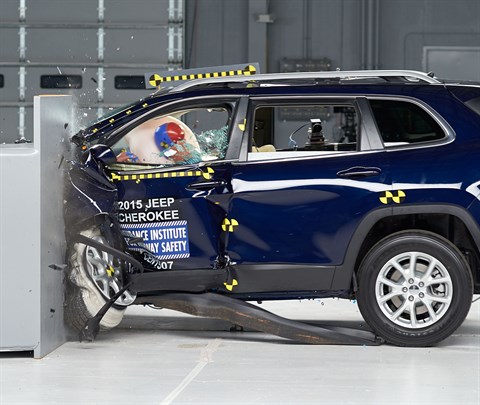
Action shot taken during the small overlap frontal crash test.
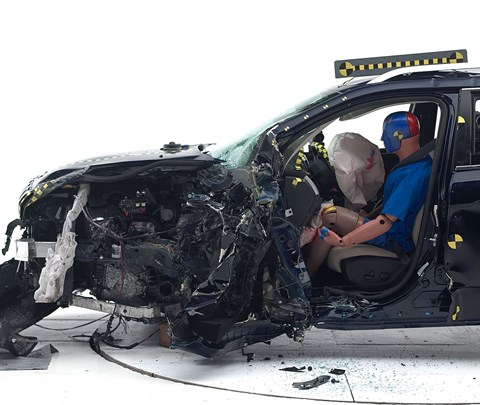
The dummy's position in relation to the door frame, steering wheel, and instrument panel after the crash test indicates that the driver's survival space was not maintained well.
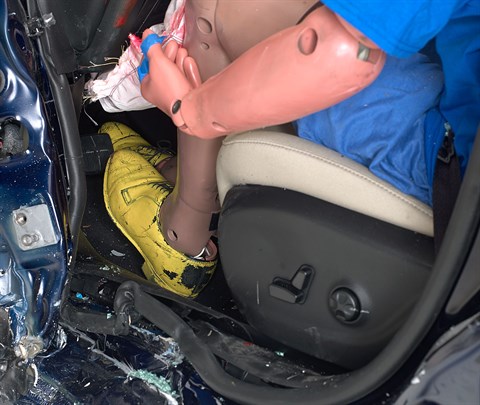
Intrusion of the door hinge pillar and instrument panel contributed to a moderate risk of injuries to the left knee and left lower leg.
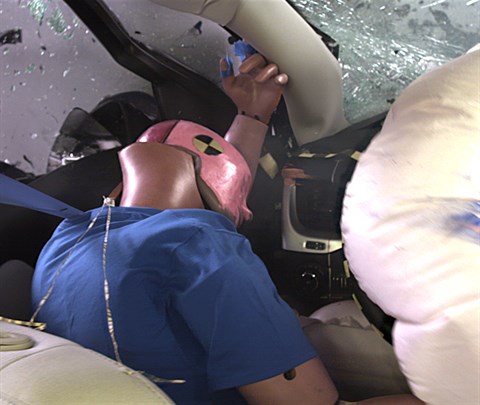
During the crash, the dummy's head barely contacted the airbag before sliding off to the left as the steering column moved to the right. The seat belt allowed the dummy to move too far forward, and the side curtain airbag did not deploy.
Measures of occupant compartment intrusion on driver side
| Test ID | CEN1507 |
|---|---|
| Lower occupant compartment | |
| Lower hinge pillar max (cm) | 21 |
| Footrest (cm) | 8 |
| Left toepan (cm) | 4 |
| Brake pedal (cm) | 2 |
| Parking brake (cm) | |
| Rocker panel lateral average (cm) | 6 |
| Upper occupant compartment | |
| Steering column | 4 |
| Upper hinge pillar max (cm) | 17 |
| Upper dash (cm) | 15 |
| Lower instrument panel (cm) | 13 |
Driver injury measures
| Test ID | CEN1507 |
|---|---|
| Head | |
| HIC-15 | 75 |
| Peak gs at hard contact | no contact |
| Neck | |
| Tension (kN) | 1.4 |
| Extension bending moment (Nm) | 20 |
| Maximum Nij | 0.35 |
| Chest maximum compression (mm) | 20 |
| Femur (kN) | |
| Left | 3.5 |
| Right | 1.6 |
| Knee displacement (mm) | |
| Left | 13 |
| Right | 6 |
| Knee-thigh-hip injury risk (%) | |
| Left | 1 |
| Right | 0 |
| Maximum tibia index | |
| Left | 0.84 |
| Right | 0.45 |
| Tibia axial force (kN) | |
| Left | 1.5 |
| Right | 1.1 |
| Foot acceleration (g) | |
| Left | 39 |
| Right | 47 |
Moderate overlap front: original test
Rating applies to 2014-18 models
Tested vehicle: 2014 Jeep Cherokee Sport 4-door 4wd
The Jeep Cherokee was re-introduced for the 2014 model year after last being sold in the U.S. as a 2001 model.
| Overall evaluation | |
|---|---|
| Structure and safety cage | |
| Driver injury measures | |
| Head/neck | |
| Chest | |
| Leg/foot, left | |
| Leg/foot, right | |
| Driver restraints and dummy kinematics |
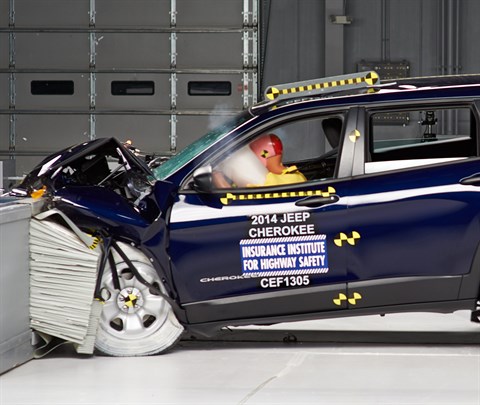
Action shot taken during the moderate overlap frontal crash test.
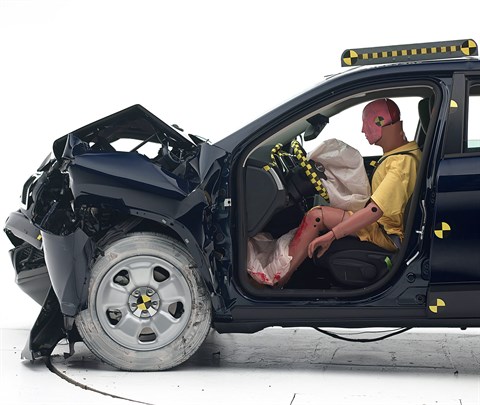
The dummy's position in relation to the steering wheel and instrument panel after the crash test indicates that the driver's survival space was maintained well.
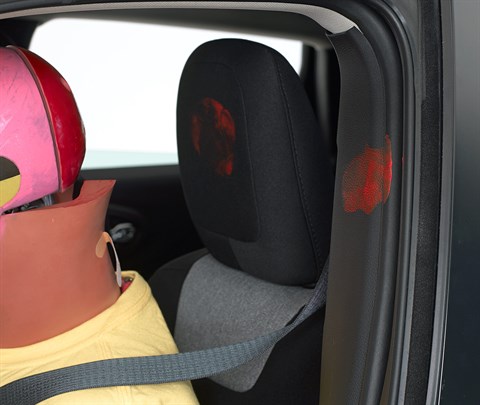
Smeared greasepaint indicates where the dummy's head hit the B-pillar and head restraint during rebound. Head accelerations from these hits were low.
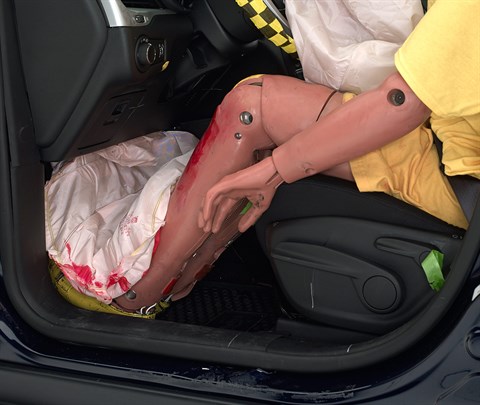
Intrusion into the driver's space was minimal, and all leg and foot injury measures were low.
Measures of occupant compartment intrusion on driver side
| Test ID | CEF1305 |
|---|---|
| Footwell intrusion | |
| Footrest (cm) | 6 |
| Left (cm) | 10 |
| Center (cm) | 9 |
| Right (cm) | 9 |
| Brake pedal (cm) | 6 |
| Instrument panel rearward movement | |
| Left (cm) | 1 |
| Right (cm) | 1 |
| Steering column movement | |
| Upward (cm) | -1 |
| Rearward (cm) | -1 |
| A-pillar rearward movement (cm) | 1 |
Driver injury measures
| Test ID | CEF1305 |
|---|---|
| Head | |
| HIC-15 | 205 |
| Peak gs at hard contact | 31 |
| Neck | |
| Tension (kN) | 1.6 |
| Extension bending moment (Nm) | 12 |
| Maximum Nij | 0.30 |
| Chest maximum compression (mm) | 24 |
| Legs | |
| Femur force - left (kN) | 2.1 |
| Femur force - right (kN) | 1.7 |
| Knee displacement - left (mm) | 4 |
| Knee displacement - right (mm) | 5 |
| Maximum tibia index - left | 0.58 |
| Maximum tibia index - right | 0.53 |
| Tibia axial force - left (kN) | 1.9 |
| Tibia axial force - right (kN) | 1.9 |
| Foot acceleration (g) | |
| Left | 70 |
| Right | 133 |
Side: original test
Rating applies to 2014-23 models
Tested vehicle: 2019 Jeep Cherokee Latitude 4-door 4wd with standard front and rear head curtain airbags, front seat-mounted torso airbags, and rear seat-mounted pelvis airbags
The Jeep Cherokee was re-introduced for the 2014 model year after last being sold in the U.S. as a 2001 model. Beginning with the 2019 model year, the Cherokee was re-engineered and restyled, but no changes affecting side crashworthiness were made. Therefore the results of two side tests of the Cherokee were combined, one of a 2014 model by the Institute and the other of a 2019 model by Fiat Chrysler as part of side crash test verification. Ratings are based on both tests, but the vehicle specifications shown below are based on Fiat Chrysler's test.
| Overall evaluation | |
|---|---|
| Structure and safety cage | |
| Driver injury measures | |
| Head/neck | |
| Torso | |
| Pelvis/leg | |
| Driver head protection | |
| Rear passenger injury measures | |
| Head/neck | |
| Torso | |
| Pelvis/leg | |
| Rear passenger head protection | |
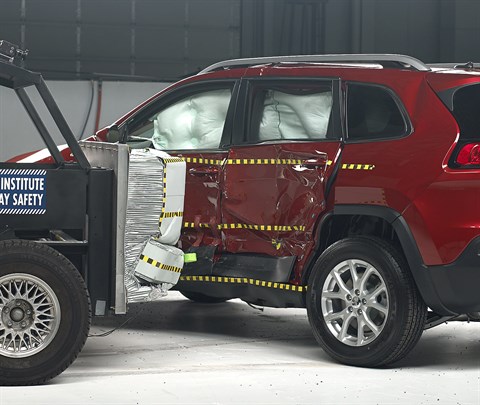
View of the vehicle and barrier just after the Institute's crash test of a 2014 model Jeep Cherokee.
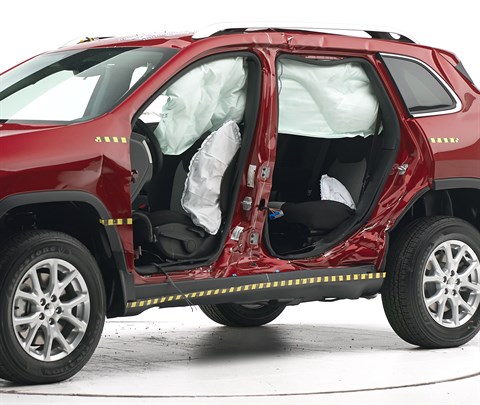
View of the vehicle after the crash with doors removed, showing the side airbags and damage to the occupant compartment (Institute test vehicle shown).
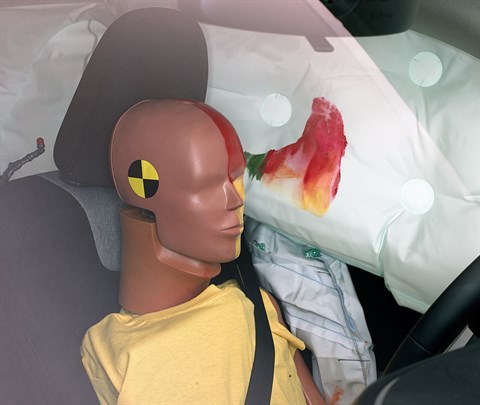
Smeared greasepaint shows where the driver dummy's head was protected from being hit by hard structures by the side curtain airbag in the Institute's test.
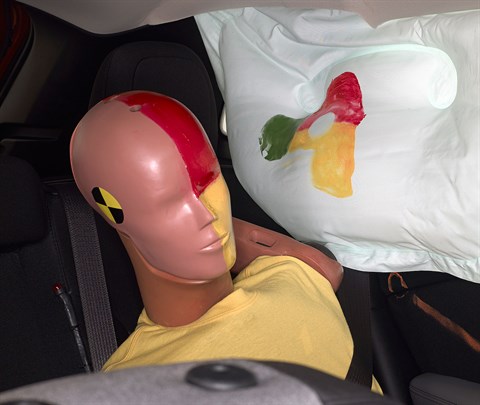
Smeared greasepaint shows where the rear passenger dummy’s head was protected by the side airbag.
Measures of occupant compartment intrusion on driver side
| Test ID | CES1308 | VTS1815 |
|---|---|---|
| B-pillar to longitudinal centerline of driver's seat (cm) | -17.5 | -17.5 |
| Negative numbers indicate the amount by which the crush stopped short of the seat centerline. | ||
Driver injury measures
| Test ID | CES1308 | VTS1815 |
|---|---|---|
| Head HIC-15 | 120 | 103 |
| Neck | ||
| Tension (kN) | 1.1 | 0.9 |
| Compression (kN) | 0.3 | 0.2 |
| Shoulder | ||
| Lateral deflection (mm) | 30 | 27 |
| Lateral force (kN) | 1.1 | 1.1 |
| Torso | ||
| Maximum deflection (mm) | 32 | 32 |
| Average deflection (mm) | 28 | 28 |
| Maximum deflection rate (m/s) | 4.67 | 4.12 |
| Maximum viscous criterion (m/s) | 0.63 | 0.62 |
| Pelvis | ||
| Iliac force (kN) | 1.7 | 1.4 |
| Acetabulum force (kN) | 1.5 | 1.9 |
| Combined force (kN) | 3.0 | 3.2 |
| Left femur | ||
| L-M force (kN) | 1.0 | 0.8 |
| L-M moment (Nm) | 63 | 83 |
| A-P moment (Nm) | -16 | 30 |
Passenger injury measures
| Test ID | CES1308 | VTS1815 |
|---|---|---|
| Head HIC-15 | 214 | 137 |
| Neck | ||
| Tension (kN) | 0.3 | 0.3 |
| Compression (kN) | 0.1 | 0.3 |
| Shoulder | ||
| Lateral deflection (mm) | 30 | 34 |
| Lateral force (kN) | 1.1 | 1.8 |
| Torso | ||
| Maximum deflection (mm) | 23 | 24 |
| Average deflection (mm) | 12 | 16 |
| Maximum deflection rate (m/s) | 2.18 | 3.44 |
| Maximum viscous criterion (m/s) | 0.15 | 0.33 |
| Pelvis | ||
| Iliac force (kN) | 0.7 | 0.3 |
| Acetabulum force (kN) | 1.3 | 2.5 |
| Combined force (kN) | 2.0 | 2.5 |
| Left femur | ||
| L-M force (kN) | 0.5 | 0.2 |
| L-M moment (Nm) | 25 | 38 |
| A-P moment (Nm) | -20 | -26 |
Roof strength
Rating applies to 2014-18 models
Tested vehicle: 2014 Jeep Cherokee Latitude 4-door 4wd
| Overall evaluation | |
|---|---|
| Curb weight | 4,022 lbs |
| Peak force | 20,114 lbs |
| Strength-to-weight ratio | 5.00 |
Head restraints & seats
Seat type: Manual cloth seat
| Overall evaluation | |
|---|---|
| Dynamic rating | |
| Seat/head restraint geometry |
| Seat type | Manual cloth seat |
|---|---|
| Geometry | |
| Backset (mm) | 38 |
| Distance below top of head (mm) | -5 |
| Seat design parameters | |
| Pass/fail | Pass |
| Max T1 acceleration (g) | 12.5 |
| Head contact time (ms) | 57 |
| Force rating | 1 |
| Neck forces | |
| Max neck shear force (N) | 23 |
| Max neck tension (N) | 360 |
How the head restraint & seat test is conducted
Currently, IIHS tests apply only to front seats.
